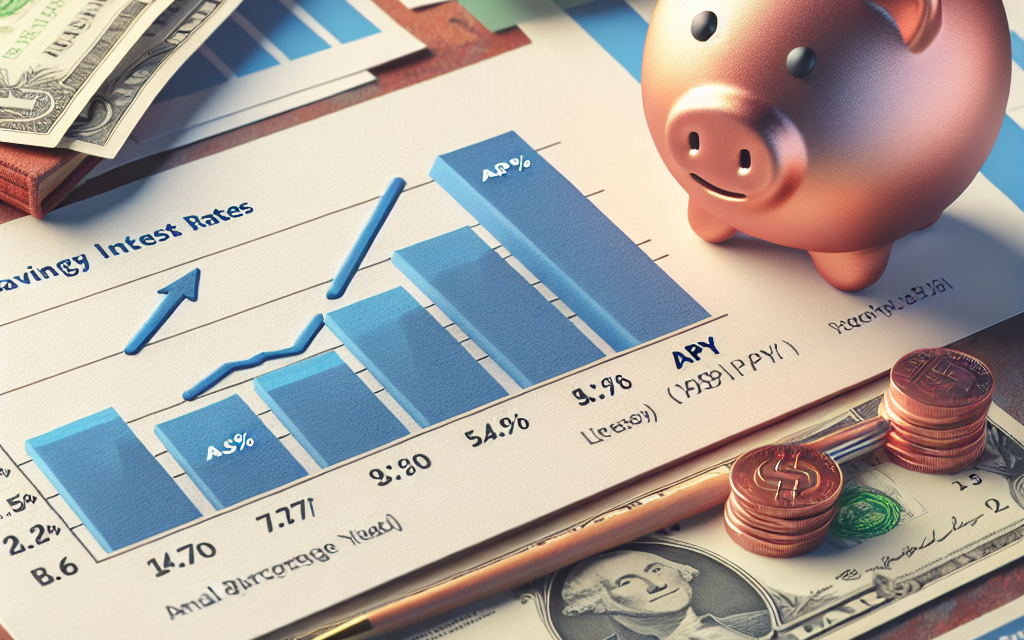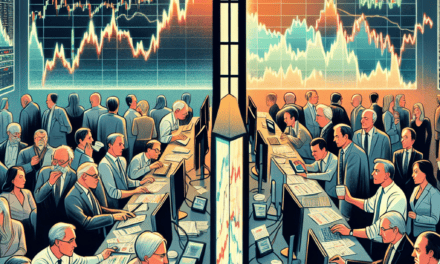“Maximize Your Savings: Enjoy the Highest APY at 4.75%!”
Introduction
As of January 13, 2025, current savings interest rates have reached notable heights, with the highest annual percentage yield (APY) available at 4.75%. This increase in rates reflects a broader trend in the financial landscape, driven by various economic factors, including inflation and monetary policy adjustments. Savers are now presented with more attractive options for growing their funds, making it an opportune time to explore high-yield savings accounts that can significantly enhance savings potential.
Current Savings Interest Rates Overview
As of January 13, 2025, the landscape of savings interest rates presents a compelling opportunity for consumers seeking to maximize their savings. With the highest annual percentage yield (APY) reaching an impressive 4.75%, individuals are encouraged to reassess their savings strategies in light of these favorable conditions. This surge in interest rates can be attributed to various economic factors, including the Federal Reserve’s monetary policy adjustments aimed at combating inflation and stimulating economic growth. Consequently, financial institutions have responded by offering more attractive rates to entice savers.
In this context, it is essential to understand the implications of these rates on personal finance. A higher APY means that savers can earn more on their deposits, which is particularly beneficial for those who prioritize building an emergency fund or saving for future goals. For instance, a savings account with a 4.75% APY can significantly enhance the growth of funds over time, especially when compounded monthly. This compounding effect allows interest to be earned not only on the initial deposit but also on the interest that accumulates, thereby accelerating the overall growth of savings.
Moreover, the competitive nature of the current savings market has led many banks and credit unions to offer promotional rates to attract new customers. As a result, consumers have a plethora of options to choose from, ranging from traditional savings accounts to high-yield online savings accounts. It is crucial for savers to compare these offerings carefully, as the terms and conditions associated with each account can vary widely. Some institutions may impose minimum balance requirements or charge monthly maintenance fees, which could diminish the overall returns on savings.
In addition to traditional savings accounts, certificates of deposit (CDs) have also seen a rise in interest rates, making them an attractive option for those willing to lock in their funds for a specified period. With rates on CDs often surpassing those of standard savings accounts, they can provide a secure way to earn a higher yield, albeit with less liquidity. Savers should weigh the benefits of higher rates against their need for access to funds, as early withdrawal penalties can apply if money is needed before the CD matures.
Furthermore, it is important to consider the broader economic environment when evaluating savings interest rates. The current high rates reflect a response to inflationary pressures, which have prompted the Federal Reserve to adopt a more aggressive stance on interest rates. While this may benefit savers in the short term, it is essential to remain vigilant about potential shifts in monetary policy that could impact future rates. As the economy evolves, so too will the landscape of savings interest rates, making it imperative for consumers to stay informed and adaptable.
In conclusion, the current savings interest rates as of January 13, 2025, present a unique opportunity for individuals to enhance their financial well-being. With the highest APY at 4.75%, savers are encouraged to explore various options and make informed decisions that align with their financial goals. By taking advantage of these favorable rates, consumers can effectively grow their savings and secure a more stable financial future. As always, staying informed about market trends and economic indicators will be key to navigating the ever-changing world of personal finance.
Top High-Yield Savings Accounts for 2025
As we enter 2025, the landscape of high-yield savings accounts continues to evolve, offering consumers a variety of options to maximize their savings. With current savings interest rates reaching an impressive annual percentage yield (APY) of 4.75% as of January 13, 2025, individuals seeking to grow their funds can benefit significantly from these competitive rates. High-yield savings accounts have become increasingly popular due to their ability to provide a higher return compared to traditional savings accounts, making them an attractive choice for both short-term and long-term savings goals.
One of the standout features of high-yield savings accounts is their accessibility. Many financial institutions now offer these accounts with minimal requirements, allowing consumers to open an account with little initial deposit. This accessibility is particularly beneficial for those who may be new to saving or who are looking to build an emergency fund. Furthermore, the online banking sector has seen a surge in competition, leading to more favorable terms and conditions for consumers. As a result, individuals can easily compare various accounts to find the one that best suits their financial needs.
In addition to competitive interest rates, many high-yield savings accounts come with no monthly maintenance fees, which can further enhance the overall return on savings. This aspect is crucial, as fees can erode the benefits of earning interest. Moreover, some institutions offer additional perks, such as sign-up bonuses or referral incentives, which can provide an extra boost to one’s savings. It is essential for consumers to read the fine print and understand the terms associated with these accounts, as some may have specific conditions that must be met to earn the advertised APY.
As we explore the top high-yield savings accounts for 2025, several institutions stand out due to their attractive rates and favorable terms. For instance, some online banks are currently offering APYs that hover around the 4.75% mark, making them highly competitive in the market. These banks often have lower overhead costs compared to traditional brick-and-mortar institutions, allowing them to pass on the savings to their customers in the form of higher interest rates. Additionally, many of these accounts provide easy online access, enabling customers to manage their funds conveniently from anywhere.
Another important consideration when selecting a high-yield savings account is the level of customer service provided by the institution. While online banks may offer higher interest rates, it is crucial to ensure that they also provide reliable customer support. This can be particularly important when dealing with account inquiries or technical issues. Therefore, prospective account holders should research customer reviews and ratings to gauge the quality of service offered by different banks.
In conclusion, the current savings interest rates as of January 13, 2025, present a favorable opportunity for individuals looking to enhance their savings through high-yield accounts. With rates reaching as high as 4.75%, consumers are encouraged to explore their options and consider the various features and benefits that different institutions offer. By taking the time to compare accounts, understand the terms, and assess customer service, individuals can make informed decisions that align with their financial goals. As the year progresses, staying informed about changes in interest rates and account offerings will be essential for maximizing savings potential.
How to Maximize Your Savings with 4.75% APY
As of January 13, 2025, the financial landscape for savers has become increasingly favorable, with savings accounts offering an impressive annual percentage yield (APY) of 4.75%. This rate presents a significant opportunity for individuals looking to maximize their savings. To fully capitalize on this high APY, it is essential to adopt a strategic approach that encompasses various aspects of saving and financial management.
First and foremost, it is crucial to identify the right financial institution that offers this competitive rate. Not all banks and credit unions provide the same APY, and some may have specific requirements or conditions attached to their high-yield savings accounts. Therefore, conducting thorough research is imperative. Look for institutions that not only offer the 4.75% APY but also have favorable terms, such as low fees, easy access to funds, and robust online banking features. By comparing different options, you can ensure that your savings are not only earning a high interest rate but are also secure and accessible.
Once you have selected a suitable financial institution, the next step is to determine how much money you can allocate to your high-yield savings account. It is advisable to set aside an emergency fund that covers three to six months of living expenses. This fund should be kept in a liquid account, allowing for quick access in case of unforeseen circumstances. After establishing your emergency fund, consider transferring additional funds into the high-yield savings account to take full advantage of the 4.75% APY. The more money you deposit, the more interest you will earn over time, compounding your savings effectively.
In addition to maximizing your initial deposit, it is beneficial to establish a regular savings habit. Setting up automatic transfers from your checking account to your high-yield savings account can help you consistently contribute to your savings without the temptation to spend. By treating your savings like a recurring expense, you can gradually build your balance and increase the interest earned. This disciplined approach not only enhances your savings but also instills a sense of financial responsibility.
Moreover, it is essential to remain informed about any changes in interest rates or account terms. Financial institutions may adjust their APYs based on market conditions, and being proactive can help you make timely decisions regarding your savings strategy. If you notice that your current institution lowers its APY or imposes unfavorable terms, it may be wise to explore other options that continue to offer competitive rates. Staying vigilant in this regard ensures that your savings are always working as hard as possible for you.
Lastly, consider diversifying your savings strategy. While a high-yield savings account is an excellent vehicle for short-term savings and emergency funds, it may also be beneficial to explore other investment options for long-term growth. Depending on your financial goals and risk tolerance, you might look into certificates of deposit (CDs), bonds, or even stock market investments. By balancing your savings across different accounts and investment vehicles, you can optimize your overall financial portfolio.
In conclusion, taking advantage of the current 4.75% APY requires a thoughtful and proactive approach. By selecting the right financial institution, establishing a solid savings habit, staying informed about market changes, and considering diversification, you can maximize your savings effectively. This strategic mindset not only enhances your financial security but also positions you for greater financial success in the future.
Comparing Traditional vs. High-Yield Savings Accounts
As of January 13, 2025, the landscape of savings accounts presents a compelling choice for consumers looking to maximize their interest earnings. With current savings interest rates reaching as high as 4.75% Annual Percentage Yield (APY), it is essential to understand the differences between traditional savings accounts and high-yield savings accounts. This comparison not only highlights the potential for increased earnings but also underscores the varying features and accessibility of these financial products.
Traditional savings accounts, typically offered by brick-and-mortar banks, have long been a staple for individuals seeking a safe place to store their funds. These accounts generally provide lower interest rates, often hovering around 0.01% to 0.10% APY. While they offer the security of FDIC insurance and easy access to funds, the minimal interest earned can significantly diminish the purchasing power of savings over time, especially in an environment of rising inflation. Consequently, consumers may find that their savings do not grow at a pace that keeps up with the cost of living, leading to a gradual erosion of wealth.
In contrast, high-yield savings accounts have emerged as an attractive alternative, particularly in the current financial climate where rates have surged. These accounts, often provided by online banks or credit unions, typically offer interest rates that are substantially higher than those of traditional savings accounts. With rates reaching up to 4.75% APY, high-yield savings accounts present a compelling opportunity for savers to earn more on their deposits. The increased interest can significantly enhance the growth of savings, making it a more effective vehicle for wealth accumulation.
Moreover, high-yield savings accounts often come with fewer fees and lower minimum balance requirements compared to their traditional counterparts. This accessibility allows a broader range of consumers to benefit from higher interest rates without the burden of maintaining a large balance. Additionally, many online banks have streamlined their services, providing user-friendly mobile apps and online platforms that facilitate easy account management. This technological advancement not only enhances the customer experience but also allows for seamless transfers and deposits, making it easier for individuals to manage their finances.
However, it is important to consider the potential drawbacks of high-yield savings accounts. While they offer attractive interest rates, these rates can fluctuate based on market conditions and the policies of the financial institution. Therefore, consumers should be aware that the APY advertised may not be guaranteed over the long term. Furthermore, some high-yield accounts may impose withdrawal limits or fees for excessive transactions, which could impact liquidity for those who need immediate access to their funds.
In conclusion, the choice between traditional and high-yield savings accounts ultimately depends on individual financial goals and preferences. For those prioritizing higher returns on their savings, high-yield accounts present a viable option, especially in light of current interest rates reaching 4.75% APY. Conversely, individuals who value the convenience and familiarity of traditional banks may find comfort in the stability of traditional savings accounts, despite their lower yields. As consumers navigate their options, it is crucial to weigh the benefits and limitations of each type of account, ensuring that their savings strategy aligns with their financial objectives.
Impact of Federal Reserve Policies on Savings Rates
The impact of Federal Reserve policies on savings rates is a critical aspect of the broader economic landscape, particularly as we observe current savings interest rates as of January 13, 2025, which have reached a notable high of 4.75% APY. Understanding the relationship between the Federal Reserve’s monetary policy and savings rates requires a closer examination of how these policies influence financial institutions and, consequently, consumers’ savings behavior.
To begin with, the Federal Reserve, as the central bank of the United States, plays a pivotal role in shaping the economic environment through its control of interest rates. When the Federal Reserve adjusts the federal funds rate, it directly influences the cost of borrowing and the return on savings. For instance, when the Fed raises interest rates, it typically leads to higher yields on savings accounts and certificates of deposit (CDs). This is because banks, facing increased costs for borrowing, tend to pass on these costs to consumers by offering higher interest rates on deposits to attract more savings. As a result, the current high savings interest rates can be seen as a direct consequence of the Fed’s recent tightening measures aimed at combating inflation.
Moreover, the Federal Reserve’s policies also affect consumer confidence and spending behavior. When interest rates are elevated, consumers may be more inclined to save rather than spend, as the opportunity cost of holding onto cash diminishes. This shift in behavior can lead to an increase in overall savings rates across the economy, further reinforcing the upward trend in savings interest rates. Consequently, as individuals prioritize saving in a higher interest rate environment, financial institutions are compelled to offer competitive rates to retain and attract deposits.
In addition to influencing consumer behavior, the Federal Reserve’s policies also have a significant impact on the broader financial markets. For example, when the Fed signals its intention to maintain higher interest rates for an extended period, it can lead to a reallocation of investments. Investors may shift their portfolios to favor fixed-income securities, such as bonds and high-yield savings accounts, which become more attractive in a rising rate environment. This shift not only affects individual investment strategies but also influences the overall liquidity in the banking system, as banks adjust their offerings to meet the changing demands of consumers and investors alike.
Furthermore, the interplay between inflation and interest rates cannot be overlooked. The Federal Reserve’s primary mandate includes maintaining price stability, and when inflation rates rise, the Fed often responds by increasing interest rates. This response is designed to cool down an overheating economy and stabilize prices. As inflationary pressures persist, the resulting higher interest rates can lead to increased savings rates, as consumers seek to preserve their purchasing power. Thus, the current savings interest rates reflect not only the Fed’s actions but also the broader economic context in which these decisions are made.
In conclusion, the current savings interest rates, highlighted by an impressive 4.75% APY, are significantly influenced by the Federal Reserve’s monetary policies. As the Fed navigates the complexities of inflation and economic growth, its decisions directly impact the rates offered by financial institutions, shaping consumer behavior and investment strategies. Understanding this dynamic relationship is essential for consumers looking to maximize their savings in an ever-evolving economic landscape. As we move forward, it will be crucial to monitor how future Federal Reserve actions will continue to influence savings rates and the overall financial environment.
Strategies for Choosing the Best Savings Account
When it comes to selecting the best savings account, understanding current savings interest rates is crucial, especially in a financial landscape where rates can fluctuate significantly. As of January 13, 2025, the highest annual percentage yield (APY) stands at an impressive 4.75%. This figure not only highlights the potential for earning interest on savings but also underscores the importance of strategic decision-making when choosing a savings account.
To begin with, it is essential to compare the APYs offered by various financial institutions. While a 4.75% APY may be enticing, it is vital to consider whether this rate is introductory or if it will remain consistent over time. Some banks may offer high initial rates that decrease after a promotional period, which can diminish the long-term benefits of your savings. Therefore, it is prudent to look for accounts that provide competitive rates without hidden stipulations or time limits.
In addition to APY, one should also evaluate the account’s fees and minimum balance requirements. Many savings accounts come with monthly maintenance fees that can erode your interest earnings. Consequently, it is advisable to seek accounts that either waive these fees under certain conditions or offer no fees at all. Furthermore, understanding the minimum balance requirements is crucial, as some accounts may require a substantial deposit to earn the advertised APY. By selecting an account with manageable balance requirements, you can maximize your interest earnings without the stress of maintaining a high balance.
Moreover, the accessibility of your funds is another critical factor to consider. While high-interest savings accounts can yield significant returns, they may also come with restrictions on withdrawals or transfers. It is essential to assess your financial needs and determine how often you may need to access your savings. Accounts that limit the number of transactions can be less flexible, potentially leading to penalties if you exceed the allowed number of withdrawals. Therefore, finding a balance between earning a competitive APY and maintaining access to your funds is vital for effective financial management.
In addition to these considerations, the reputation and stability of the financial institution should not be overlooked. Opting for a bank or credit union with a solid track record and positive customer reviews can provide peace of mind. Institutions that are insured by the Federal Deposit Insurance Corporation (FDIC) or the National Credit Union Administration (NCUA) offer an added layer of security, ensuring that your deposits are protected up to certain limits. This assurance can be particularly important in times of economic uncertainty, as it safeguards your hard-earned savings.
Lastly, it is beneficial to stay informed about changes in interest rates and market conditions. Financial institutions frequently adjust their rates in response to economic trends, and being aware of these changes can help you make timely decisions regarding your savings. Regularly reviewing your savings account and comparing it with other available options can ensure that you are always maximizing your interest earnings.
In conclusion, choosing the best savings account requires careful consideration of various factors, including APY, fees, accessibility, and the institution’s reputation. By employing these strategies, you can navigate the financial landscape more effectively and make informed decisions that align with your savings goals. As interest rates continue to evolve, staying proactive and informed will empower you to optimize your savings potential.
Future Predictions for Savings Interest Rates in 2025
As we look ahead to 2025, the landscape of savings interest rates is poised for potential shifts that could significantly impact consumers and investors alike. With the current average annual percentage yield (APY) for savings accounts reaching as high as 4.75% as of January 13, 2025, many are left wondering whether this trend will continue or if a decline is on the horizon. Several factors will play a crucial role in determining the trajectory of savings interest rates throughout the year.
To begin with, the actions of the Federal Reserve will be a primary influence on interest rates. The Fed’s monetary policy decisions, particularly regarding the federal funds rate, have a direct correlation with the rates offered by banks and financial institutions. If the Fed opts to maintain or even increase rates in response to ongoing inflationary pressures, it is likely that savings interest rates will remain elevated. Conversely, should the Fed decide to lower rates to stimulate economic growth, we could see a corresponding decrease in savings interest rates, which would affect the returns that consumers earn on their deposits.
Moreover, the overall economic environment will also play a significant role in shaping savings interest rates in 2025. Factors such as inflation, employment rates, and consumer spending will influence banks’ willingness to offer competitive rates. If inflation continues to rise, banks may be compelled to offer higher interest rates to attract deposits, as consumers seek to preserve their purchasing power. On the other hand, if inflation stabilizes or decreases, banks may feel less pressure to offer high rates, leading to a potential decline in APY.
In addition to macroeconomic factors, competition among financial institutions will be another critical element affecting savings interest rates. As more consumers become aware of the benefits of high-yield savings accounts, banks may engage in a competitive race to attract deposits. This competition could result in higher interest rates as institutions strive to differentiate themselves in a crowded market. However, if the market becomes saturated with high-yield offerings, the incentive for banks to maintain elevated rates may diminish, leading to a stabilization or reduction in APY.
Furthermore, technological advancements and the rise of fintech companies are reshaping the savings landscape. Online banks and neobanks often offer higher interest rates than traditional brick-and-mortar institutions due to their lower overhead costs. As these digital platforms continue to gain popularity, they may drive traditional banks to reevaluate their interest rate offerings to remain competitive. This dynamic could lead to a more favorable environment for consumers seeking higher returns on their savings.
In conclusion, while the current savings interest rates are at an impressive 4.75%, the future of these rates in 2025 remains uncertain and will be influenced by a multitude of factors. The Federal Reserve’s monetary policy, the broader economic environment, competition among financial institutions, and the impact of technological advancements will all play pivotal roles in shaping the savings landscape. As consumers navigate this evolving terrain, staying informed about these trends will be essential for making sound financial decisions. Ultimately, whether rates rise, fall, or stabilize, understanding the underlying factors will empower individuals to optimize their savings strategies in the coming year.
Q&A
1. **What is the highest APY for savings accounts as of January 13, 2025?**
4.75%
2. **Which type of account typically offers the highest APY?**
High-yield savings accounts.
3. **Are online banks more likely to offer higher APYs than traditional banks?**
Yes, online banks often provide higher APYs due to lower overhead costs.
4. **What factors can influence savings interest rates?**
Economic conditions, Federal Reserve policies, and competition among banks.
5. **Is the APY the same as the interest rate?**
No, APY (Annual Percentage Yield) accounts for compounding, while the interest rate does not.
6. **Can savings interest rates change over time?**
Yes, they can fluctuate based on market conditions and bank policies.
7. **What should consumers consider when choosing a savings account?**
APY, fees, account minimums, and withdrawal restrictions.
Conclusion
As of January 13, 2025, current savings interest rates are notably high, with the highest annual percentage yield (APY) reaching 4.75%. This reflects a competitive savings environment, encouraging consumers to seek out accounts that offer the best returns on their deposits.





